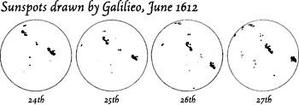Glossarbegriffe: Sonnenfleck
Description: Ein Sonnenfleck ist eine dunkle Stelle auf der sichtbaren Sonnenoberfläche (Photosphäre), der durch ein starkes Magnetfeld erzeugt wird. Sonnenflecken sind Bereiche, in denen Bündel von Magnetfeldlinien aus dem Sonneninneren austreten. Das starke Magnetfeld erhöht den magnetischen Druck in diesen Regionen. Um den gleichen Druck wie die Umgebung aufrechtzuerhalten, muss der Gas- und Plasmadruck im Sonnenfleck sinken. Dadurch wird er kühler als seine Umgebung, weshalb Sonnenflecken durch Teleskope gesehen als dunkle Flecken auf der Sonnenoberfläche erscheinen. Sonnenflecken können einige zehn Kilometer bis zu über hunderttausend Kilometern durchmessen. Sie können über einen Zeitraum von einigen Tagen bis zu einigen Monaten bestehen bleiben. Die Anzahl und Lage der Sonnenflecken auf der Sonne verändert sich im Laufe des Sonnenzyklus. Es wird angenommen, dass auch andere Sterne Flecken haben, die durch ihre Magnetfelder verursacht werden.
Zugehörige Glossarbegriffe:
See this term in other languages
Term and definition status: The original definition of this term in English have been approved by a research astronomer and a teacher The translation of this term and its definition is still awaiting approval
The OAE Multilingual Glossary is a project of the IAU Office of Astronomy for Education (OAE) in collaboration with the IAU Office of Astronomy Outreach (OAO). The terms and definitions were chosen, written and reviewed by a collective effort from the OAE, the OAE Centers and Nodes, the OAE National Astronomy Education Coordinators (NAECs) and other volunteers. You can find a full list of credits here. All glossary terms and their definitions are released under a Creative Commons CC BY-4.0 license and should be credited to "IAU OAE".
If you notice a factual or translation error in this glossary term or definition then please get in touch.
Zugehörige Medien
Sunspots
Bildnachweis: NASA/SDO/HMI credit link
License: PD Public Domain icons
Related Activities
Measure the Sun's Rotation Period
astroEDU educational activity (links to astroEDU website) Description: Find out the Sun’s rotation period, applying the simple equation of average speed to a real astronomical case.
License: CC-BY-4.0 Creative Commons Namensnennung 4.0 International (CC BY 4.0) icons
Tags:
Hands-on
, History
, Experiment
, Galileo
, average speed
Age Ranges:
16-19
Education Level:
Secondary
Areas of Learning:
Social Research
Costs:
Low Cost
Duration:
1 hour 30 mins
Group Size:
Group
Skills:
Analysing and interpreting data
, Engaging in argument from evidence
, Planning and carrying out investigations
, Using mathematics and computational thinking
Is the Sun rotating? Follow the sunspots!
astroEDU educational activity (links to astroEDU website) Description: Like a "modern" Galileo, use true astronomical satellite observations to discover if the Sun (and other celestial objects) are rotating!
License: CC-BY-4.0 Creative Commons Namensnennung 4.0 International (CC BY 4.0) icons
Tags:
Hands-on
, History
, Experiment
, Galileo
Age Ranges:
12-14
, 14-16
, 16-19
Education Level:
Middle School
, Secondary
Areas of Learning:
Social Research
Costs:
Low Cost
Duration:
1 hour
Group Size:
Group
Skills:
Analysing and interpreting data
, Planning and carrying out investigations











